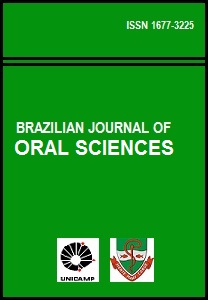Abstract
The temporomandibular joint disorder is characterized by pain and tenderness in the temporomandibular joint and in the masticatory muscles. Muscle hyperactivity can be of significant characteristic in subjects with Temporomandibular Disorders, which can be associated with pain and muscle fatigue. The aim of this study was to compare the electromyographic activity behavior of the major chewing muscles (anterior temporalis and masseter muscles) by using Parafilm material through analysis of the electromyographic signals before and after massage therapy. Sixty young adult female subjects, 17 to 27 years old, formed the total sample group. It was divided into twenty subjects with normal occlusion and no history of temporomandibular disorder, and forty subjects with signs and/or symptoms of TMD from parafunctional habits (excessively hard chewing or repeated forced mandibular opening and bruxism), which were then subdivided into twenty subjects who were submitted to physiotherapeutic treatment (massage), and twenty subjects who were not submitted to treatment. The masticatory activity was performed with the subjects comfortably sat, with the Frankfurt plane parallel to the floor. Electromyographic exams were carried out using bipolar surface differential electrodes positioned on the anterior body of the temporalis muscle and on the masseter muscles. The subjects were then instructed to bite bilaterally and simultaneously on the material. For the study of the masticatory activity the electromyographic signals were processed through rectification, linear envelope, and the coefficient of variation obtained from the procedure was comparatively analyzed. All the data collected was submitted for further analyzes of the variance. The study of the electromyographic signals of the masticatory activity in the isotonic contractions of the muscles in study was registered, stored, and analyzed by the RMS values (Root Mean Square). Moreover, the Analogue Visual Scale was utilized to assess the subject’s pain pre and post treatment. The results of this study indicated that the massage therapy decreased muscle hyperactivity, promoting better relaxation. Also, 87% of the subjects presented significant improvement of the TMD symptoms and sings. In general, this treatment is indicated as a complement of other treatment plans. The electromyographic exams are very important to analyze muscular activity; in addition, many authors agree that the common etiologic factor for TMD is the muscle hyperactivity. There is a substantial relationship between TMD and hyperactivity of the temporal muscle, and the physiotherapeutic treatment (massage) can reduce and eliminate pain and hyperactivity.References
Dahlström L. Electromyographic studies of craniomandibular disorders: a review of the literature. J Oral Rehabil. 1989; 16: 1- 20.
Yemm R. A neurophysiological approach to the pathology and etiology of temporomandibular dysfunction. J Oral Rehabil. 1985; 12: 343-53.
Ash MM. Current concepts in the etiology, diagnosis and treatment of TMJ and muscle dysfunction. J Oral Rehabil. 1986; 13: 1-20.
Phillips RW, Hamilton AI, Jendresen MD, McHorris WH, Schallhorn RG. Report of the committee on scientific investigation of the American Academy of Restorative Dentistry. J Prosthet Dent. 1986; 55: 736-72.
Okeson JP. Fundamentos de oclusão e desordens temporomandibulares. 2.ed. São Paulo: Artes Médicas; 1992.
Steenks MH, De Wijer A. Disfunções da articulação temporomandibular do ponto de vista da fisioterapia e da odontologia. São Paulo: Santos; 1996.
Moss RA, Garret JC. Temporomandibular joint dysfunction syndrome and myofascial pain syndrome: a critical review. J Oral Rehabil. 1984; 11: 3-28.
Eversole LR, Machado L. Temporomandibular joint internal derangement and associated neuromuscular disorders. J Am Dent Assoc. 1985; 110: 69-79.
Okeson JP. Dores odontogênicas. In: Okeson JP. Dores bucofaciais de Bell. 5.ed. São Paulo: Quintessense; 1998. Cap.11, p.235-58.
Bérzin F. Estudo eletromiográfico da hiperatividade de músculos mastigatórios, em pacientes portadores de desordem crâniomandibular (DCM) com dor miofascial. In: Anais do 4º Simpósio Brasileiro e Encontro Internacional Sobre Dor. São Paulo; 1999. p.405.
Abekura H, Kotani H, Tokuyama H, Hamada T. Effects of oclusal splints on the asymmetry of masticatory muscle activity during maximal clenching. J Oral Rehabil. 1995; 22: 747-52.
Ferreira JAND. Efeito da placa estabilizadora do tipo Michigan sobre a atividade elétrica dos músculos temporal anterior e masseter de pacientes com hábito de bruxismo [dissertation]. Piracicaba: FOP/UNICAMP; 2001.
Naeji M, Hansson TL. Short-term effect of the stabilization appliance on mastigatory muscle activity in mtogenous craniomandibular disorder patients. J Craniomandib Disord. 1991; 5: 245-50.
Beard G. History of massage technique. Phys Ther. 1952; 32: 613-24.
Bell AJ. Massage and the physiotherapist. Phys Ther. 1964; 50: 406-8.
Biasotto DA. Estudo eletromiográfico dos músculos do sistema estomatognático durante a mastigação de diferentes materiais [dissertation]. Piracicaba: FOP/UNICAMP; 2000.
Huskisson EC. Measurement of pain. Lancet. 1974; 2: 1127- 31.
Joyce CRB, Zutshi DW, Hrubes V, Mason RM. Comparison of fixed interval and visual analogue scales for rating chronic pain. Eur J Clin Pharmacol. 1975; 8: 415-20.
Amadio AC, Duarte M. Fundamentos biomecânicos para análise do movimento. São Paulo: Editora Laboratório de Biomecânica EEFUSP; 1996. 162p.
Nordschow M, Bierman W. Influence of manual massage on muscle relaxation: Effect on trunk flexion. Phys Ther. 1962; 42:653-6.
The Brazilian Journal of Oral Sciences uses the Creative Commons license (CC), thus preserving the integrity of the articles in an open access environment.

